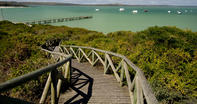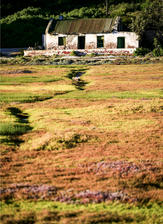Flying the Flag
With the building of the outpost, at Kraal Bay in the West Coast National Park, the original compliment of soldiers was increased to 15. The French have never been known to back down from a challenge, and so it was that French Admiral De la Haye and his fleet of ships carrying soldiers invaded the post in 1670.

The 15 Dutch soldiers proved no match for the 200 French soldiers and were all captured. The French destroyed the VOC monogram there and raised the French flag. The post holder, a sergeant by the name of Hieronijmus Cruse, was told he would be hanged if he removed it. Cruse escaped though, making his way to Cape Town to report on the attack. The French released the remainder of the soldiers a few days later when they set sail once more.
C’est la vie! A year later, Georg Wreede took command of the area and commissioned a carpenter to create five VOC monograms, one of each being erected on five of the seven islands in the lagoon and its mouth. But the incorrigible Dutch again erected their VOC flag a year later at the post and five soldiers were once again sent to resume guard and rebuild the now dilapidated post house, situated south of Langebaan town.
Later, three of the soldiers returned to Cape Town with a herd of sheep. The remaining two soldiers were easy pickings for the Khoi who murdered them both. With the soldiers gone, local fishermen, the “Saldanhavaarders,” loyal to the Dutch VOC, were given the job of guarding the post. They were also tasked with providing up to 10 000 fish a month to feed the slaves and inhabitants in the Cape.
Quarantine Camp
Langebaan Lagoon, being salt, rather than freshwater, was dismissed by the early Cape Commander Jan van Riebeeck as a place to establish a colony. Although there were two fresh water springs, they did not produce enough water. (The one waterhole delivered only 72 litres of water a day, while an average ship required roughly 560 litres.) Langebaan nevertheless had several resources the Dutch were quick to utilise.
(Gannets provided feathers for pillows, guano was used as a fertiliser for the establishment of Cape gardens and bird eggs, fish and penguins were a good food source.) It soon became a hive of early Cape activity. As early as 1654, van Riebeeck sent ships to collect nearly 1 600 penguins and birds’ eggs to feed VOC slaves. The safe harbour provided a good place to repair ships and was also used as a quarantine camp for sailors with infectious diseases and a recovery station for sailors.
A smallpox epidemic broke out in 1882, wiping out much of the population. The camp was later closed, only to be reopened during the Anglo-Boer war after an outbreak of bubonic plague and smallpox. Today Langebaan provides excellent kite and boardsailing opportunities, as well as an area for boating and fishing enthusiasts.
Die Oude Post

The French had been visiting the area since 1601, looking for trade opportunities with the Khoi. In 1668, The French, wanting to leave their colony in Madagascar and base themselves in Saldanha Bay, erected a flagpole with a lead plate at the largest waterhole with the inscription of the coat of arms of Lodewyk XV1. By the time the Dutch soldiers arrived to claim the territory officially, the French had left, but the Dutch were faced with the problem of how to reclaim the territory.
This proved no problem for one enterprising Anthonij Bosman, who promptly burnt the French flagpole and its insignia. Freemen (called burghers) started moving into the area from 1658, developing farmlands, to provide passing ships with fresh food. The enterprising action by farmers to trade provisions to ships, was not taken kindly by the Dutch who wanted the revenue from sales for their own coffers.
To gain revenue from trade and to thwart the French from any further attempts to claim the land, Van Riebeeck had the area surveyed in 1659 and under instructions from the VOC erected a small garrison called Oude Post (Old Post). Four Dutch soldiers were sent to occupy and guard the two main watering holes, until reinforcements could be sent. Once the reinforcements arrived, the soldiers set about finding the best location to erect a post house.
Battle of Saldanha
In 1685 the Dutch army once more resumed duties at the post, sending seven soldiers to guard the place and acquire fish. Although the French threatened, no further invasions took place. By the following year they had produced 7 800 pounds of salted fish for the Cape. Seven soldiers though were not enough to maintain rule in the area and several pirates, seized upon the opportunity to make the lagoon their home.
It proved an ideal hideaway to spot passing ships and then quickly make their way out of the lagoon mouth to attack and then retreat, laden with their spoils, into the safety of the lagoon and its many hideaway spots. Between 1729 and 1730, Oude Post was moved 2km north in the bay between Konstabelskop and Vlaeberg. Fifty years later, it became the backdrop for a battle between the Dutch and English.
The British then assumed control of the area in 1781 at the naval Battle of Saldanha, where the victorious British under Commodore George Johnson captured several Dutch ships (one being destroyed by the Dutch themselves). The Dutch also set fire to the outpost. It was later rebuilt by the British and used as a base to supply passing ships with fresh water and supplies, as well as to defend the area from further European invasion.
By Ann Gadd Langebaan, few towns in South Africa exude as much of a beachy-breakaway feel as this spread-out dorp shimmering along the West Coast shores...
Langebaan, few towns in South Africa exude as much of a beachy-breakaway feel as this spread-out dorp shimmering along the West Coast shores...